General Performance
Starting out with the overall system performance benchmarks, we have PCMark05, 3DMark03/05/06, and a couple 3D rendering tests. We will also include the CPU results from the 3DMark applications. Note that 3DMark05/06 have multithreaded CPU tests, while 3DMark03 does not.
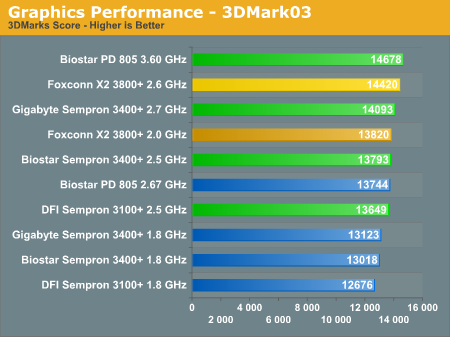

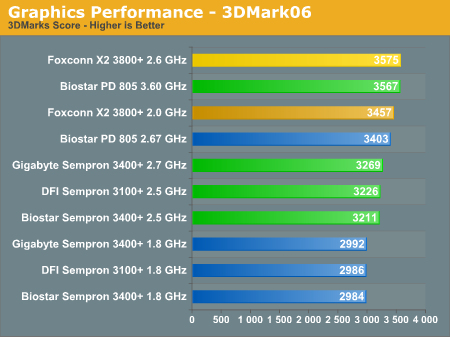
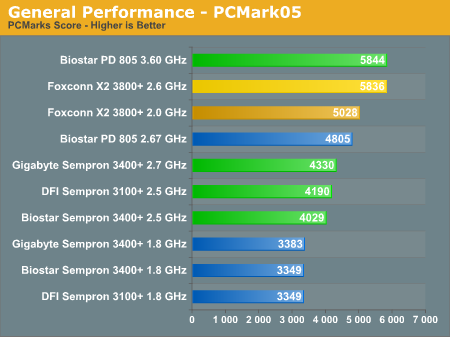
The Pentium D 805 makes an immediate impression as a high-performance budget offering. The margins in 3DMark are not very large, but the Pentium D comes out ahead in all three benchmarks, both at stock speeds and when overclocked. Given that PCMark05 includes several multitasking tests, the greater margin of victory isn't too surprising. However, even if the results are somewhat expected, it does not change the fact that the Pentium D makes a great budget setup for anyone that does moderate amounts of multitasking. If we consider the X2 3800+, it comes out ahead of the Pentium D 805 at stock clock speeds, but overclocking -- at least with this particular graphics card -- results in a dead heat.
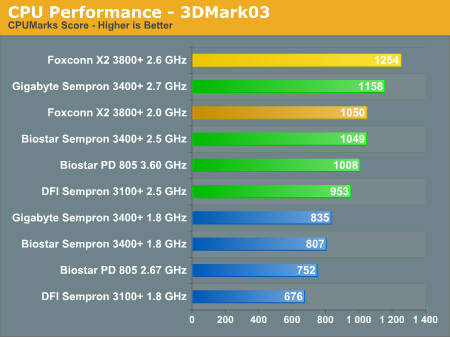
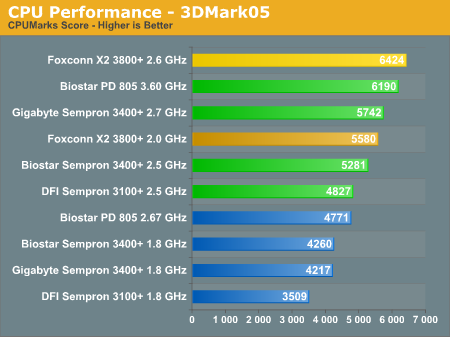
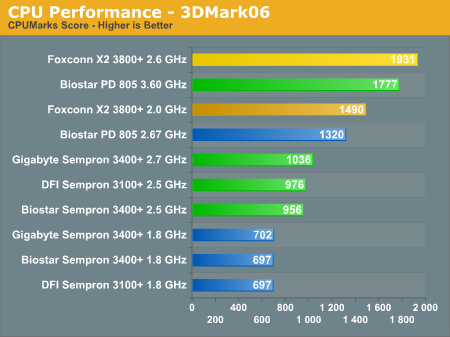
Looking at the 3DMark CPU results, things begin to spread out quite a bit. The X2 3800+ easily leads in these benchmarks, in both stock and overclocked configurations. If we ignore the X2 chip, the Pentium D 805 has a commanding lead in the multithreaded 3DMark05/06, while it trails several of the other systems in 3DMark03. We always mention how 3DMark is really a synthetic graphics benchmark as opposed to real gaming benchmarks, and the same applies to the CPU benchmarks within the 3DMark applications. They show the potential your CPU has to outperform other processors under certain situations, but whether or not real applications perform similarly is going to depend on many factors. Dual core systems definitely have more potential performance, but unfortunately the vast majority of games remain single threaded applications.
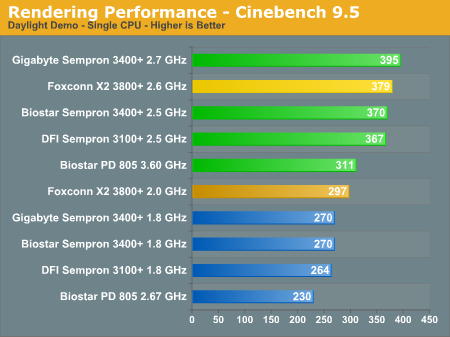
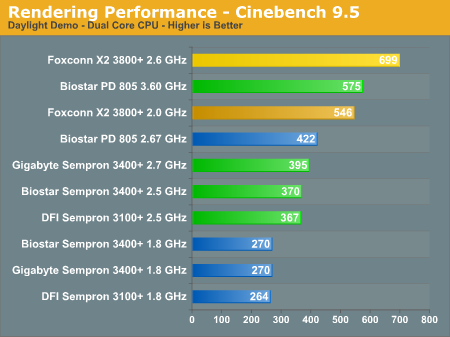
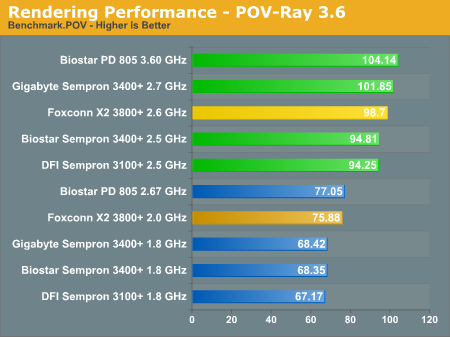
Shifting over to 3D rendering, the Sempron systems are able to do quite well in the single threaded rendering tests. Once SMP support is enabled in Cinebench, the 83% performance increase that the Pentium D and X2 gain easily eclipses the other offerings. POV-Ray also seems to like the NetBurst architecture as the result from our overclocked Pentium 805 is at the top of the chart. It's unfortunate that POV-Ray doesn't support multiple processors, but we could say the same thing about many other applications.
Starting out with the overall system performance benchmarks, we have PCMark05, 3DMark03/05/06, and a couple 3D rendering tests. We will also include the CPU results from the 3DMark applications. Note that 3DMark05/06 have multithreaded CPU tests, while 3DMark03 does not.




The Pentium D 805 makes an immediate impression as a high-performance budget offering. The margins in 3DMark are not very large, but the Pentium D comes out ahead in all three benchmarks, both at stock speeds and when overclocked. Given that PCMark05 includes several multitasking tests, the greater margin of victory isn't too surprising. However, even if the results are somewhat expected, it does not change the fact that the Pentium D makes a great budget setup for anyone that does moderate amounts of multitasking. If we consider the X2 3800+, it comes out ahead of the Pentium D 805 at stock clock speeds, but overclocking -- at least with this particular graphics card -- results in a dead heat.



Looking at the 3DMark CPU results, things begin to spread out quite a bit. The X2 3800+ easily leads in these benchmarks, in both stock and overclocked configurations. If we ignore the X2 chip, the Pentium D 805 has a commanding lead in the multithreaded 3DMark05/06, while it trails several of the other systems in 3DMark03. We always mention how 3DMark is really a synthetic graphics benchmark as opposed to real gaming benchmarks, and the same applies to the CPU benchmarks within the 3DMark applications. They show the potential your CPU has to outperform other processors under certain situations, but whether or not real applications perform similarly is going to depend on many factors. Dual core systems definitely have more potential performance, but unfortunately the vast majority of games remain single threaded applications.



Shifting over to 3D rendering, the Sempron systems are able to do quite well in the single threaded rendering tests. Once SMP support is enabled in Cinebench, the 83% performance increase that the Pentium D and X2 gain easily eclipses the other offerings. POV-Ray also seems to like the NetBurst architecture as the result from our overclocked Pentium 805 is at the top of the chart. It's unfortunate that POV-Ray doesn't support multiple processors, but we could say the same thing about many other applications.










56 Comments
View All Comments
JarredWalton - Monday, July 10, 2006 - link
Drop the $180 GPU and throw in a $50 GPU and you've got a non-gaming platform.mino - Wednesday, July 12, 2006 - link
Wrong,i.e.: changes to make 754 config a good budget PC:
drop DFI MB, drop the GPU, put in quality ATI Xpress200 or Geforce 6100 MB
drop that dual channel Patriot nonsense for singel channel s754, put in Kinkston/
Corsair 1GB stick of DDR400 CL3
drop that insane 400W PSU(100W system), drop in budget case, drop in FSP300-60GLN
example:
CPU: Sempron 2800+ ~$50
MB: JetWay A200GDMS ~$70 or some Geforce6100 board
RAM: 1GB brand DDR400 ~$90
HDD: any 250G ~$80
DVD: NEC 4571 ~$35 or any you like
case: ASUS TM250 ~$30 or any generic case without PSU
PSU: FSP300-60GLN ~$30
Final price: <= $400
You can drop some better GPU later but such a system will be with you for a long time.
As someone wrote above, your configs are good budget GAMER/OVERCLOCKER choices. Not budget PC choices.
JarredWalton - Wednesday, July 12, 2006 - link
But I would quantify my system as a "better" budget system - the extra $200 or so goes a long ways towards improving features and performance. Again, you don't *have* to buy these systems, but they are what I had available and you can see performnace (stock and OC'ed). It's something a bit different from our regular budget buyers' guides.mino - Thursday, July 13, 2006 - link
Almost forgot,I really appreciated the review, realy.
Just not for the text part, instead for the numbers and mostly the configs being tested.
mino - Thursday, July 13, 2006 - link
IMHO we have a common attitude for system config creation. But a different view on what a budget PC is. For me, it is a -as cheap as possible- workhorse, for you, a gaming machine able to work.My intention was just to show off that it is not so simple - like change the GPU and it is a classic budget system. IMHO you know that it is more complicated, but many readers do not(an the article supports them here).
the message:
"To build a good, balanced PC is a system solution problem, not a component solution one."
Best regards.
mino - Wednesday, July 12, 2006 - link
Wrong,i.e.: changes to make 754 config a good budget PC:
drop DFI MB, drop the GPU, put in quality ATI Xpress200 or Geforce 6100 MB
drop that dual channel Patriot nonsense for singel channel s754, put in Kinkston/
Corsair 1GB stick of DDR400 CL3
drop that insane 400W PSU(100W system), drop in budget case, drop in FSP300-60GLN
you've got:
CPU: Sempron 2800+ $50
MB:
mino - Wednesday, July 12, 2006 - link
this post was unintentional, gog give us EDIT :)Josh7289 - Monday, July 10, 2006 - link
So, the Pentium D's are going even lower, when the X2's lower as well? What about the other single cores from Intel and AMD, are they lowering with Core 2 Duo's launch?Looking back at that article from one and a half years ago. it's pretty cool to see what one can get today for less money than what one could get back then. I remember reading that article last year shortly before I built the PC I use now and using it as a kind of guideline, even though it was a few months old then.
Anyway, this spell check on Firefox 2.0 Beta 1 is freaking sweet. :)
PC Surgeon - Monday, July 10, 2006 - link
The review overall was very good. But I do have one problem and it has to do with this statement:
"Still, we're inclined to recommend socket AM2 right now, as we have yet to see any budget socket 775 motherboards available that will support Core 2 Duo chips.
Oh yeah? Well what about this one?
ASRock 775Dual-VSTA $58.99 www.newegg.com/Product/Product.asp?Item=N82E16813157092
It supports Conroe, DDR, DDRII, AGP, PCI-e....which to me is somewhat the equevelent of the ASROCK 939DUAL SATAII. For people with older systems that have DDR, or AGP, the 775Dual-VSTA is the board that can make the transition a little cheaper.
Why you guys didn't recommend this board I don't know...maybe you didnt know about it? Or worse (and I doubt this is true) it was showing AMD bias.
That's my bone to pick....
JarredWalton - Monday, July 10, 2006 - link
I will let Gary's review explore overclocking on the ASRock motherboard. I really have no idea how it will perform, and the truth is that I started working on this article several weeks ago. If I knew for sure which budget motherboards can run Core 2 Duo and overclock well, I would be happy to recommend such a motherboard. We'll probably have to wait a few more weeks to get a clear feel for that market.